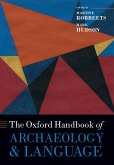Antonis Iliopoulos
Early Body Ornaments and the Origins of Our Semiotic Mind
Herausgeber: Paschalidis, Gregory
Versandkostenfrei innerhalb Deutschlands
127,99 €
inkl. MwSt.
Versandkostenfrei*
Erscheint vorauss. 5. Februar 2026
Melden Sie sich
hier
hier
für den Produktalarm an, um über die Verfügbarkeit des Produkts informiert zu werden.

64 °P sammeln
Antonis Iliopoulos
Early Body Ornaments and the Origins of Our Semiotic Mind
Herausgeber: Paschalidis, Gregory
- Gebundenes Buch
Accounts for the co-emergence of early body ornaments and our semiotic mind, by employing a cognitive semiotic theory based on pragmatism and enactivism.
Andere Kunden interessierten sich auch für
![The Oxford Handbook of Archaeology and Language The Oxford Handbook of Archaeology and Language]() The Oxford Handbook of Archaeology and Language239,99 €
The Oxford Handbook of Archaeology and Language239,99 €![Two Papers On the Oscan Word Anasaket Two Papers On the Oscan Word Anasaket]() Lionel Graham Horton Horton-SmithTwo Papers On the Oscan Word Anasaket29,99 €
Lionel Graham Horton Horton-SmithTwo Papers On the Oscan Word Anasaket29,99 €![Semiotic Insights Semiotic Insights]() Irmengard RauchSemiotic Insights71,99 €
Irmengard RauchSemiotic Insights71,99 €![Phrases and Names, Their Origins and Meanings Phrases and Names, Their Origins and Meanings]() Trench H JohnsonPhrases and Names, Their Origins and Meanings31,99 €
Trench H JohnsonPhrases and Names, Their Origins and Meanings31,99 €![The Writing Culture of Ancient Dadān The Writing Culture of Ancient Dadān]() Fokelien KootstraThe Writing Culture of Ancient Dadān133,99 €
Fokelien KootstraThe Writing Culture of Ancient Dadān133,99 €![On The Polyphony Of The Asssyro-babylonian Cuneiform Writing On The Polyphony Of The Asssyro-babylonian Cuneiform Writing]() Edward HincksOn The Polyphony Of The Asssyro-babylonian Cuneiform Writing28,99 €
Edward HincksOn The Polyphony Of The Asssyro-babylonian Cuneiform Writing28,99 €![The Bloomsbury Handbook of Saussure The Bloomsbury Handbook of Saussure]() The Bloomsbury Handbook of Saussure171,99 €
The Bloomsbury Handbook of Saussure171,99 €-
-
-
Accounts for the co-emergence of early body ornaments and our semiotic mind, by employing a cognitive semiotic theory based on pragmatism and enactivism.
Produktdetails
- Produktdetails
- Verlag: Bloomsbury Academic
- Seitenzahl: 304
- Erscheinungstermin: 5. Februar 2026
- Englisch
- Abmessung: 234mm x 156mm x 28mm
- Gewicht: 454g
- ISBN-13: 9781350260078
- ISBN-10: 135026007X
- Artikelnr.: 74319577
- Herstellerkennzeichnung
- Libri GmbH
- Europaallee 1
- 36244 Bad Hersfeld
- gpsr@libri.de
- Verlag: Bloomsbury Academic
- Seitenzahl: 304
- Erscheinungstermin: 5. Februar 2026
- Englisch
- Abmessung: 234mm x 156mm x 28mm
- Gewicht: 454g
- ISBN-13: 9781350260078
- ISBN-10: 135026007X
- Artikelnr.: 74319577
- Herstellerkennzeichnung
- Libri GmbH
- Europaallee 1
- 36244 Bad Hersfeld
- gpsr@libri.de
Antonis Iliopoulos is a postdoctoral researcher for the ERC HANDMADE project at the University of Oxford, UK, which explores creative gesture in pottery-making.
Foreword
List of Figures
List of Tables
List of Appendix Tables
1. Early Body Ornaments
1.1 Debate on Modern Human Origins
1.2 Spatiotemporal Distribution of Early Shell Beads
1.3 Blombos Inference
1.4 Prime Movers of Ornamentation
1.5 Structure of the Book
Part I: The Nature of Material Signification
2. Search For the Optimal Semiotic Theory
2.1 The Nature of Material Signification in Evolutionary Archaeology
2.2 The Nature of Material Signification in Theoretical Archaeology
2.3 The Optimal Theory for Describing the Nature of Past Material
Signification
2.4 Summary
3. Outline of the Peircean Semiotic Theory
3.1 Peirce's Sign
3.2 Three Triads
3.3 Peirce's Tenfold Typology of Signs
3.4 Summary
4. Application of the Peircean Semiotic Theory
4.1 Re-Evaluating the Nature of Symbolism
4.2 Rethinking the Nature of Ornamental Signs
4.3 Extending the Nature of Ornamental Signs
4.4 Summary
Part II: The Emergence of Material Signification
5. Search For The Optimal Evolutionary Theory
5.1 The Emergence of Material Signs In Evolutionary Archaeology
5.2 The Optimal Theory for Tracing the Emergence of Past Material
Signification
5.3 Summary
6. Outline of a Pragmatic and Enactive Theory of Cognitive Semiotics
6.1 Phenomenological Background
6.2 Pragmatic and Enactive Signification
6.3 Aesthetic Material Signs
6.4 Summary
7. Application of a Pragmatic and Enactive Theory of Cognitive Semiotics
7.1 The Emergence of Iconic, Indexical, and Symbolic Body Ornamentation
7.2 The Emergence of Aesthetic Body Ornamentation and Cultural Identity
7.3 The Emergence of Human Selfhood through Ornament-Based Rituals
7.4 Summary
8. The Origins of our Semiotic Mind
Bibliography
Appendix
Index
List of Figures
List of Tables
List of Appendix Tables
1. Early Body Ornaments
1.1 Debate on Modern Human Origins
1.2 Spatiotemporal Distribution of Early Shell Beads
1.3 Blombos Inference
1.4 Prime Movers of Ornamentation
1.5 Structure of the Book
Part I: The Nature of Material Signification
2. Search For the Optimal Semiotic Theory
2.1 The Nature of Material Signification in Evolutionary Archaeology
2.2 The Nature of Material Signification in Theoretical Archaeology
2.3 The Optimal Theory for Describing the Nature of Past Material
Signification
2.4 Summary
3. Outline of the Peircean Semiotic Theory
3.1 Peirce's Sign
3.2 Three Triads
3.3 Peirce's Tenfold Typology of Signs
3.4 Summary
4. Application of the Peircean Semiotic Theory
4.1 Re-Evaluating the Nature of Symbolism
4.2 Rethinking the Nature of Ornamental Signs
4.3 Extending the Nature of Ornamental Signs
4.4 Summary
Part II: The Emergence of Material Signification
5. Search For The Optimal Evolutionary Theory
5.1 The Emergence of Material Signs In Evolutionary Archaeology
5.2 The Optimal Theory for Tracing the Emergence of Past Material
Signification
5.3 Summary
6. Outline of a Pragmatic and Enactive Theory of Cognitive Semiotics
6.1 Phenomenological Background
6.2 Pragmatic and Enactive Signification
6.3 Aesthetic Material Signs
6.4 Summary
7. Application of a Pragmatic and Enactive Theory of Cognitive Semiotics
7.1 The Emergence of Iconic, Indexical, and Symbolic Body Ornamentation
7.2 The Emergence of Aesthetic Body Ornamentation and Cultural Identity
7.3 The Emergence of Human Selfhood through Ornament-Based Rituals
7.4 Summary
8. The Origins of our Semiotic Mind
Bibliography
Appendix
Index
Foreword
List of Figures
List of Tables
List of Appendix Tables
1. Early Body Ornaments
1.1 Debate on Modern Human Origins
1.2 Spatiotemporal Distribution of Early Shell Beads
1.3 Blombos Inference
1.4 Prime Movers of Ornamentation
1.5 Structure of the Book
Part I: The Nature of Material Signification
2. Search For the Optimal Semiotic Theory
2.1 The Nature of Material Signification in Evolutionary Archaeology
2.2 The Nature of Material Signification in Theoretical Archaeology
2.3 The Optimal Theory for Describing the Nature of Past Material
Signification
2.4 Summary
3. Outline of the Peircean Semiotic Theory
3.1 Peirce's Sign
3.2 Three Triads
3.3 Peirce's Tenfold Typology of Signs
3.4 Summary
4. Application of the Peircean Semiotic Theory
4.1 Re-Evaluating the Nature of Symbolism
4.2 Rethinking the Nature of Ornamental Signs
4.3 Extending the Nature of Ornamental Signs
4.4 Summary
Part II: The Emergence of Material Signification
5. Search For The Optimal Evolutionary Theory
5.1 The Emergence of Material Signs In Evolutionary Archaeology
5.2 The Optimal Theory for Tracing the Emergence of Past Material
Signification
5.3 Summary
6. Outline of a Pragmatic and Enactive Theory of Cognitive Semiotics
6.1 Phenomenological Background
6.2 Pragmatic and Enactive Signification
6.3 Aesthetic Material Signs
6.4 Summary
7. Application of a Pragmatic and Enactive Theory of Cognitive Semiotics
7.1 The Emergence of Iconic, Indexical, and Symbolic Body Ornamentation
7.2 The Emergence of Aesthetic Body Ornamentation and Cultural Identity
7.3 The Emergence of Human Selfhood through Ornament-Based Rituals
7.4 Summary
8. The Origins of our Semiotic Mind
Bibliography
Appendix
Index
List of Figures
List of Tables
List of Appendix Tables
1. Early Body Ornaments
1.1 Debate on Modern Human Origins
1.2 Spatiotemporal Distribution of Early Shell Beads
1.3 Blombos Inference
1.4 Prime Movers of Ornamentation
1.5 Structure of the Book
Part I: The Nature of Material Signification
2. Search For the Optimal Semiotic Theory
2.1 The Nature of Material Signification in Evolutionary Archaeology
2.2 The Nature of Material Signification in Theoretical Archaeology
2.3 The Optimal Theory for Describing the Nature of Past Material
Signification
2.4 Summary
3. Outline of the Peircean Semiotic Theory
3.1 Peirce's Sign
3.2 Three Triads
3.3 Peirce's Tenfold Typology of Signs
3.4 Summary
4. Application of the Peircean Semiotic Theory
4.1 Re-Evaluating the Nature of Symbolism
4.2 Rethinking the Nature of Ornamental Signs
4.3 Extending the Nature of Ornamental Signs
4.4 Summary
Part II: The Emergence of Material Signification
5. Search For The Optimal Evolutionary Theory
5.1 The Emergence of Material Signs In Evolutionary Archaeology
5.2 The Optimal Theory for Tracing the Emergence of Past Material
Signification
5.3 Summary
6. Outline of a Pragmatic and Enactive Theory of Cognitive Semiotics
6.1 Phenomenological Background
6.2 Pragmatic and Enactive Signification
6.3 Aesthetic Material Signs
6.4 Summary
7. Application of a Pragmatic and Enactive Theory of Cognitive Semiotics
7.1 The Emergence of Iconic, Indexical, and Symbolic Body Ornamentation
7.2 The Emergence of Aesthetic Body Ornamentation and Cultural Identity
7.3 The Emergence of Human Selfhood through Ornament-Based Rituals
7.4 Summary
8. The Origins of our Semiotic Mind
Bibliography
Appendix
Index







